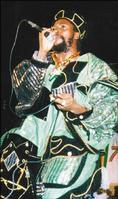
CAPLETON
Alicia Roache, Staff Reporter
DANCEHALL IS a culture that defines and celebrates Jamaican fashion. Those who want to keep abreast of what the latest in fashion has to offer often look to the street parties and many stage shows that are held across the island. At these shows the fashion changes like the weather and if you blink you might just as easily miss the latest styles as you would the latest dance moves.
But while many entertainers try to 'dress up' for the shows, not every entertainer has a distinguishable style. Style in and of itself is more than the prevailing fashion trend. It is something that defines the individual. The website dictionary.com defines style as "a quality of imagination and individuality expressed in one's actions and tastes". That person will have an identifiable quality that distinguishes their style from others'. Fashion, on the other hand, is simply "the prevailing style or custom". A person who wears the latest stilettos and all the latest colours is fashionable.
The stylish and the fashionable person can both 'look good'; one just has a better concept of who they are and this is reflected in their 'style'.
An entertainer therefore, and in fact anyone, can be fashionable, but not stylish. Also, they can be stylish but not fashionable. So which local entertainers are stylish and which are fashionable? Premier designer for the dancehall culture, 'Biggie', says that is a question not so easily answered. "Everybody have dem likkle ting still," he says. "Some entertainers place great emphasis on him appearance on stage; another entertainer just waan know seh him reach a di show."
Popular entertainer, Beenie Man, is one of those artistes in the former category. Many persons believe that Beenie Man is one of the more 'stylish' entertainers in the business. Biggie agrees. "Beenie Man ever try to look flashy. Him nuh wear one type a fashion. Him nuh really restrict himself. Him remind me of Shabba," he said. Indeed, Beenie's outfits can range from the edgy to the urbane, but his style is never pedestrian.
Having a personal style is an asset that cannot be underestimated, according to Biggie. "When a artiste come to me fi get someting the first ting mi ask him is 'wha a yuh image?'," he says. An identifiable image, according to Biggie, goes a long way in promoting the artiste, especially in an international market. "Shabba conquer dem because him never dress American. Him nuh inna di baseball jersey and dem ting deh," he said.
TRYING TO LOOK LIKE INT'L RAP STARS
According to Biggie, many artistes are trying to look like international rap stars, to the detriment of their personal style. "Dem a wear a lot of T-shirt and branded jerseys," he said. "Nuh care who di artist is, if yuh stand up inna T-shirt that boring."
Among the myriad cultural artistes who all seem to follow the one fashion, khaki and/or red, green and gold, stands the one entertainer who distinguishes himself by his ornate, sometimes garish outfits. To the untrained eye, Capleton might seem like an unlikely candidate for a style award. However, Capleton's style is as loud and ostentatious as his fire-burning image. He has reinvented the shiny suit, added the colours of the rainbow to the fabrics, while spikes rest on his shoulders and matching shoes on his feet.
Capleton's designer, Balla, in a previous interview explained the phenomenon of Rasta's dressing alike. "Most Rastas dress in the military looking outfit like they are in some army. Not all Rastas look alike, but they like looking that way," he said. Capleton, however, is distinguished because both the DJ and the designer like to "experiment with different colours.
"Other colours bring out your personality as well too," says Balla. At the other end of the colour spectrum is Bounty Killer. Bounty is the anti-colour in the dancehall. Bounty's signature all-black look reinforces his warlord image. His style suggests that there is nothing flirty and fun about him. As Calvin Haye, another local dancehall designer explains, Bounty's style is no coincidence. "A killer dress full suit a black with shades and hat in place," Haye said. Bounty is recognisable by his attire on any show; in fact, anywhere he appears.
So too is Elephant Man. He reserves the right to entertain with his look, his antics and his style. Haye calls him the 'costume king'. No other entertainer in the dancehall looks like Elephant Man.
Ironically, the women in the dancehall are less stylish and more fashionable than the men. This may be because fashion allows more freedom for women to explore many different styles. Men, however, are constrained by what they can and cannot wear. According to Haye, while his present muse entertainer Sasha is developing a 'style' like that of a diva most other female entertainers are mired in the image of the dancehall: "Short skirt, cut up, skin showing, belly showing, you name it," he dismissed them.
Cecile disagrees with this interpretation of dancehall fashion and the women who wear it. For them it is simply a matter of dressing the part, a part which may change as frequently as the outfits do. "The only time they see a dancehall artiste is when we perform at dancehall events. I think dancehall has its own fashion. Dem nuh si we when we deh a Germany and Amsterdam and dem place deh. When we're at functions with Mary J Blige and Eve you dress different. When you're at a hard-core function you dress hard-core," she says.














